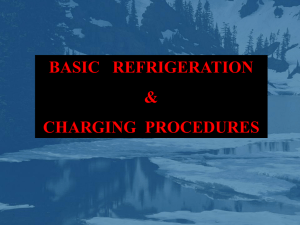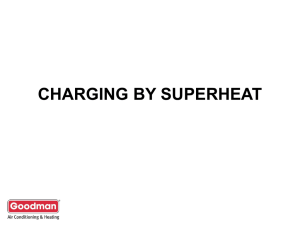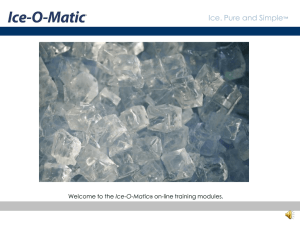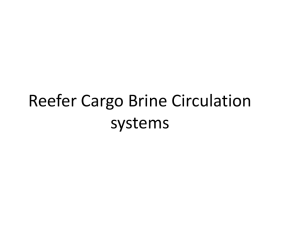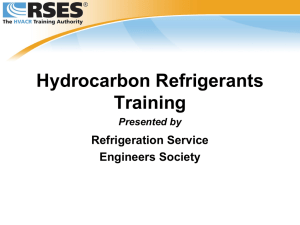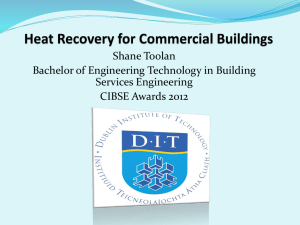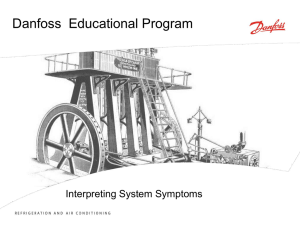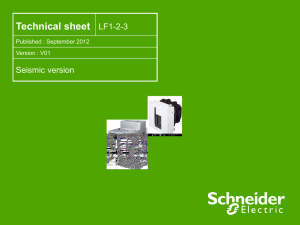evaporators_and_superheat
advertisement
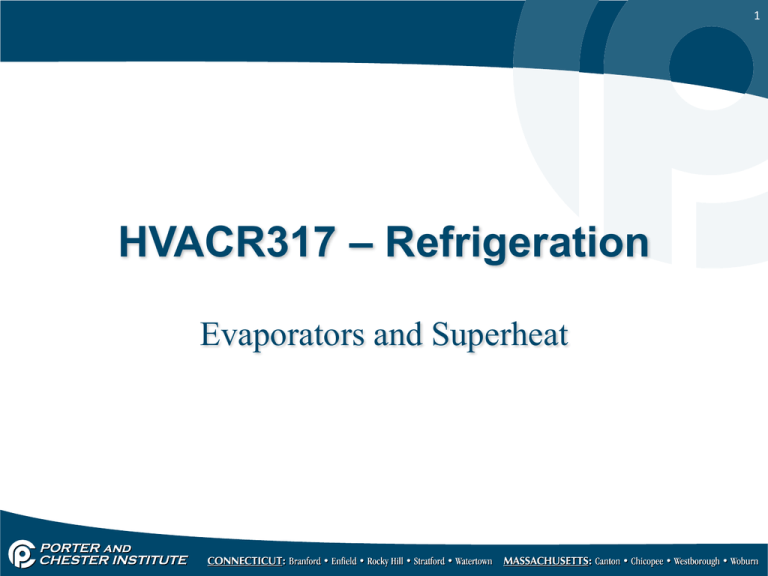
1 HVACR317 – Refrigeration Evaporators and Superheat 2 Evaporators • Two principle types – Natural convection: Does not use any mechanical means to move cold air away from evaporator. – Forced convection: Uses fans or blowers to move air around coil. 3 Evaporator Operating Design • Direct expansion – The refrigerant directly cools the air. – Most HVAC systems and refrigeration systems. • Indirect expansion – The refrigerant cools a medium such as water and this medium cools the air. – Chilled water systems. 4 Evaporator Types • Two types of evaporators – Dry type – Flooded type 5 Dry Type Evaporator • 25% less refrigerant than the flooded type, which means more vapor in the evaporator. • The advantages are: – Less refrigerant – Less chance of flood back 6 Dry Type Evaporator • Disadvantages: – Slower pull-down under heavy loads – System runs with higher head pressures 7 Flooded Type Evaporator • Almost all liquid in the evaporator. • Advantages: – 50% more effective than dry expansion. – Liquid refrigerant is in direct contact with most coil surfaces. – Used in chillers where the water coil is submerged in refrigerant. 8 Flooded Type Evaporator • Disadvantages – Larger charges of refrigerant are required. – There is a greater chance of flood back to the compressor. 9 Evaporator Types • There are several types of evaporators: − − − − − − − Plate Shelf Wall Fin and Tube Bare Coil Gravity Forced Air 10 Plate Type Evaporator • The plate type (when found at the back of the refrigerator) is the last part of the evaporator. • As the suction gas comes out of the plate, it returns directly to the compressor. • If plate used in shelves, it is used for contact freezing (conduction). • Has no fans. Plate Type Evaporator, Cont’d • Used in conduction and convection to absorb heat. • Used in domestic refrigerators and freezers. 11 12 Shelf Type Evaporator • • • • Has no fans. Used in domestic refrigerators and freezers. Use conduction and convection to absorb heat. Built directly into the shelf of domestic refrigerators and freezers. • Can be damaged by using knives and hammers to remove ice from shelves. 13 Wall Type Evaporator • Used in chest freezers and coolers like the white reach-in freezers found in stores. • No coil visible; it is built into the wall of the freezer. 14 Fin and Tube Type Evaporator • Fin and Tube with forced circulation is a commercial type or high-end residential type evaporator. • Requires a fan • More efficient operation. 15 Bare Coil Type Evaporator • Bare Coil type is not as efficient; has less surface area. • Used in older systems. • Used in immersed systems where liquid is in contact with entire coil. 16 Gravity Type Evaporator • Gravity type evaporator is used where high relative humidity is desired. • Lower coil temperature difference between supply and return. • Used in deli cases. • No fan; cold air falls on its own, hot air rises. 17 Forced Air (Blower) Type Evaporator • Forced Air (Blower) type is used in frost- free domestic refrigerators (i.e., those without a defrost cycle). • Normal air flow draws through the coil. • The most widely used type in commercial refrigeration. 18 Evaporator Purposes • Cooling – Remove the sensible heat • Dehumidification – Remove the latent heat and cause a change of state from vapor to water. 19 Evaporator Design • Things that affect evaporator efficiency and capacity: – Surface Area – Temperature Difference – Refrigerant velocity (speed) – Conductibility – Metal Thickness – Air Volume 20 Evaporators, General Info • A low temperature evaporator must be defrosted periodically to prevent ice buildup. • This defrost is required any time the evaporator operates under 32° F. • Ice will cause superheat problems, a loss of efficiency, and compressor problems. 21 Evaporators, General Info. • Defrosting a low temperature evaporator coil can be accomplished by the use of an electric heater or a hot gas bypass from the compressor discharge line. 22 Additional Notes • A dirty evaporator and subsequent low evaporator pressures will cause low head pressure. • The defrost cycle is initiated by a time clock. • The defrost cycle is terminated by time, temperature, or pressure. 23 Additional Notes • With a direct expansion evaporator coil, the refrigerant must boil away as close to the end of the coil as possible in order to a) ensure that frost does not accumulate; and b) to operate at high efficiency. 24 Superheat • Is a sensible heat added to the vapor refrigerant after the change of state has taken place. • Is the difference between the boiling refrigerant and the suction line temperature. 25 Superheat • Is used to check if the evaporator has proper level of refrigerant. • Is gained in the evaporator – refrigerant picks up additional sensible heat after the change in state takes place. 26 Superheat • Normal superheat is between 8-12° F for a TXV system. – Depending on the application, this can be much lower or higher. • If the superheat is high, causes can be: – Starved coil – Low refrigerant 27 Superheat • If the superheat is low, causes can be: – Flooded coil – To much refrigerant • Caution: DO NOT adjust refrigerant with superheat alone, unless you are sure that you know how the system should work! • Complete vaporization of refrigerant should occur around the last bend of the evaporator. 28 Superheat • Any additional heat absorbed is now referred to as superheat. • The TXV as a metering device is designed to maintain proper superheat. • With a fixed orifice metering device or a cap tube: – Adding charge lowers superheat – Removing charge raises superheat 29 Measuring superheat • Take the temperature of the suction line with a thermometer. – Best to do within 6 inches of the evaporator. • Take the suction pressure and convert to the temperature of saturation. • Subtract the saturation temperature from the suction line temperature. 30 Measuring Superheat • Example: – R22 system – Suction Pressure is 68.5psi (40°F) – Suction line temp is 50°F – 50 – 40 = superheat of 10°F 31 Measuring Superheat • Add 2 psi to your suction line if: – Condenser is in remote location. – Suction line is well over 8 feet. – You are working on a split system. 32 Troubleshooting with superheat • Domestic and commercial units: – 8 to 12 degrees of superheat is the rule of thumb. • Whatever must be done to superheat the opposite must be done to the refrigerant. 33 Troubleshooting with superheat • If you have a superheat of 20 degrees – Superheat must be lowered – Increase refrigerant charge (or flow). • If you have a superheat of 2 degrees – Superheat must be raised – Decrease refrigerant charge (or flow). 34 Troubleshooting with superheat • Any time you make a superheat adjustment you must wait 10 to 15 minutes prior to making the next adjustment. • This wait allows the system to stabilize. 35 Additional Notes • The difference between the temperature of the refrigerant boiling in the evaporator and the temperature at the evaporator outlet is known as the evaporator superheat. 36 Additional Notes • When measuring evaporator superheat on a commercial system with a long suction line, the pressure reading should be taken at the evaporator outlet, not the compressor inlet. 37 Additional Notes • Superheat measurements are best taken with the system operating at design conditions. 38 Additional notes • Evaporators can by multi-pass. This means the coil has been folded over on itself or is actually 2 or three coils clamped together and fed by a distributor. 39 Additional Notes • When an evaporator coil is multi-pass and has a superheat that is higher than others, this can be caused by un-even air distribution, a blocked distributor, or even a dirty coil section. 40 Additional Notes • Evaporators that are used to chill liquids, like the ones found in ‘slushy’ machines and soda dispensers, can have a normal superheat measurement but not be cooling properly. This is caused by deposits built up on the liquid side of the evaporator or poor circulation of the liquid.
